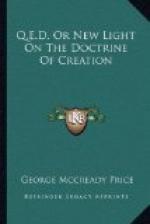Thus in many fairly independent ways we are brought around to this same idea of a common structure underlying all the many seeming diversities manifested by what we call matter.
The phenomena of radioactivity were discovered accidentally in 1896 by the French chemist Becquerel. Many investigators immediately began working along this promising line, and two years later Madam Curie, in association with others, discovered the new element radium. Soon it was discovered that radium and several other substances are continually giving off radiations at an enormous rate, that no change of chemical combination, no physical change of condition appears to have the slightest effect in slowing or increasing this discharge of emanations, while no scientific apparatus yet devised can detect any change in the substances left behind either in respect to weight or any other properties as the result of these enormous losses of energy. Accordingly some people not unnaturally were ready to draw the conclusion that those most firmly established laws of physics and chemistry, the laws of the conservation of energy and of matter, were overthrown by this astonishing behavior of these newly discovered substances. However, only a few more years of study and investigation were necessary to prove that this last conclusion was wholly unwarranted; and to-day these laws of the conservation of energy and of matter are more firmly established than ever.
The thing that has gone by the board is the old idea of the atoms as the indivisible and irreducible minima of the material universe. For not only do all the radioactive substances give off particles of helium gas positively electrified, but all bodies, no matter what their composition, can by suitable treatment, such as exposing them to ultra-violet light, or raising them to incandescence, be made to give off electrons or negatively charged particles, and these electrons are always the same no matter from what kind of substance they come. In a somewhat similar way, we always get positively electrified particles of the mass of the hydrogen atom, or about 1,760 times the mass of the electron, whenever we send an electric charge through a gas at very low pressure, no matter what the kind of gas. Whether or not these positive units will yet prove susceptible of being split up into smaller particles comparable to the electrons, is merely a subject for conjecture. We have no proof that they will. At the present time what we call matter seems to be composed of these positive units and of the electrons which are about 1/1760 as great; and in the present state of our knowledge these facts suffice to explain all the properties of matter. Thus we can either say that electricity is composed of matter, or say that matter is composed of electricity; and human language at best is such a clumsy vehicle of thought that scientifically and philosophically the one statement is as correct and as reasonable as the other.




